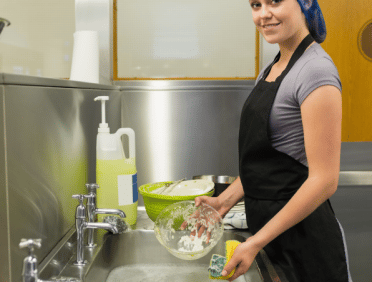Why is food hygiene and safety important?
Food hygiene and safety are essential to prevent the spread of foodborne illnesses and ensure that the food we consume is safe for consumption. Proper food hygiene and safety practices help prevent contamination of food by harmful bacteria, viruses, and other pathogens that can cause serious illnesses such as salmonella, E. coli, and listeria.
The consequences of consuming contaminated food can range from mild discomfort to severe illness and even death, particularly for vulnerable populations such as the elderly, young children, pregnant women, and individuals with weakened immune systems.
Furthermore, poor food hygiene and safety can also result in financial losses for businesses in the food industry, damage to reputation, and legal implications.
By following proper food hygiene and safety practices, such as washing hands and surfaces regularly, storing and preparing food at the correct temperatures, and ensuring proper food handling and storage, we can reduce the risk of foodborne illnesses and ensure the safety of the food we eat.
Why is food safety important in the food industry?
Food safety is critical in the food industry for several reasons:
Protecting consumers: The primary reason for ensuring food safety in the food industry is to protect consumers from the risk of foodborne illnesses. Food safety is essential to ensure that the food produced, distributed, and sold is safe for consumption and free from harmful contaminants that can cause illness.
Legal requirements: Food safety regulations and laws exist to ensure that food businesses comply with safety standards to protect public health. Failure to meet these requirements can lead to legal action, such as fines or closure of the business.
Reputation: A food safety incident can significantly damage a business’s reputation, leading to lost sales and consumer trust. Businesses that prioritise food safety can maintain a positive reputation and build customer loyalty.
Financial implications: Food safety incidents can have severe financial implications for businesses, including legal fees, compensation claims, and loss of revenue. Ensuring food safety can help to minimise these risks and protect a company’s financial interests.
How do you ensure food safety?
Ensuring food safety requires a comprehensive approach that includes several practices. Here are some ways to ensure it:
- Proper hygiene practices: Maintaining good personal hygiene, such as washing hands before handling food, wearing clean clothes, and keeping hair tied back, can prevent contamination of food.
Click here to access our FREE personal hygiene poster for the workplace
- Proper storage: Storing food at the correct temperature can help prevent the growth of harmful bacteria. This includes storing perishable foods in the refrigerator at or below 4°C and frozen foods at or below -18°C.
- Proper cooking and reheating: Cooking food at the right temperature can help kill harmful bacteria. Using a food thermometer to ensure that food is cooked to the correct temperature can help reduce the risk of foodborne illnesses. Additionally, reheating food to at least 74°C can help kill any bacteria that may have grown during storage.
Click here to access our FREE food temperatures poster for the workplace
- Proper handling: Proper handling of food, such as using separate cutting boards for raw meat and vegetables, can prevent cross-contamination.
- Regular cleaning and sanitising: Regular cleaning and sanitising of surfaces, utensils, and equipment can prevent the growth of harmful bacteria.
- Training and education: quality training and education for food handlers on food safety practices are essential to ensure that they understand the importance of food safety and how to implement safe practices.
Food safety principles
Hazard Analysis and Critical Control Points (HACCP): HACCP is a systematic approach to identifying and controlling potential hazards in the food production process. It involves identifying critical control points in the food production process and implementing measures to control potential hazards at these points.
- Cleanliness and hygiene
- Temperature control
- Cross-contamination prevention
- Traceability
- Allergen control
- Training and education
Complying with food safety regulations
Complying with food safety regulations requires businesses to familiarise themselves with the contents of relevant regulations, develop and implement food safety plans, regularly train employees, maintain records, conduct regular audits, and respond promptly to food safety issues.
Let’s take a closer look at relevant regulations:
Food Hygiene Regulations 2006
Key points of the Food Hygiene Regulations 2006 include:
General food hygiene requirements: The regulations require food businesses to ensure that food is produced, prepared, and distributed in a hygienic manner to prevent contamination and the growth of harmful bacteria.
HACCP-based food safety management system: Food businesses need to implement a food safety management system based on Hazard Analysis and Critical Control Points (HACCP) principles. This involves identifying potential hazards in the food production process and implementing measures to control these hazards at critical control points.
- Training and supervision: Food businesses must ensure that their employees receive adequate training and supervision in food safety practices.
- Temperature control: ensure that food is stored, cooked, and reheated at the correct temperature to prevent bacteria.
- Cross-contamination prevention: implement measures to prevent cross-contamination of food, such as using separate equipment and utensils for different types of food.
- Traceability: keep records that enable food to be traced, from the supplier to the end consumer.
- Allergen control: prevent the contamination of food with common allergens, such as peanuts, wheat, milk, and eggs.
- Food premises and equipment: Food premises and equipment must be designed, constructed, and maintained in a way that facilitates good hygiene practices and prevents contamination of food.
Hazard Analysis and Critical Control Points (HACCP)
Hazard Analysis and Critical Control Points (HACCP) is a systematic approach to food safety management that involves identifying potential hazards in the food production process and implementing measures to control these hazards at critical control points. Key components of HACCP are:
- Hazard analysis: The first step of HACCP is to identify potential hazards in the food production process, including biological, chemical, and physical hazards.
- Critical control points (CCPs): CCPs are points in the food production process where hazards can be controlled, such as cooking, cooling, and storage. These points are identified during the hazard analysis step.
- Establishing critical limits: Critical limits are the criteria that must be met at each CCP to ensure that the hazard is controlled. For example, the minimum cooking temperature to kill bacteria.
- Monitoring procedures: Monitoring procedures are put in place to ensure that the critical limits are met at each CCP.
- Corrective actions: When monitoring indicates that a critical limit has not been met, corrective actions should be taken. This may involve adjusting the process or product to bring it back into compliance.
- Record-keeping: HACCP requires documentation of hazard analysis, CCPs, critical limits, monitoring procedures, and corrective actions taken.
- Verification: HACCP plans must be verified to ensure that they are effective in controlling hazards. This may involve testing products or reviewing records.
Natasha’s Law
Natasha’s Law is a relatively new food safety law in the UK that requires food businesses to provide full ingredient and allergen labelling on pre-packaged foods for direct sale to consumers. The law is named after Natasha Ednan-Laperouse, who tragically died from an allergic reaction to a sandwich containing sesame seeds that was purchased from a food retailer at an airport.
Natasha’s Law came into effect on 1 October 2021 and applies to all food businesses that sell prepackaged food for direct sale to consumers, including cafes, restaurants, schools and supermarkets. The law requires these businesses to provide a label that lists all ingredients and allergens contained in the food, including the name of the food and the business that produced it.
The purpose of Natasha’s Law is to protect consumers with food allergies or intolerances by providing them with clear and accurate information about the food they are consuming. By making it mandatory for food businesses to provide detailed allergen information on pre-packaged food for direct sale, consumers can make informed decisions about the food they purchase and consume.
Natasha’s Law was a significant step forward in food safety regulations in the UK and has been widely welcomed by allergy support groups and consumers with food allergies or intolerances.
The Food Labelling Rules 2014
The Food Labelling Rules 2014 is a set of regulations in the UK that outlines the requirements for labelling and packaging of food products sold to consumers. The rules apply to all food products sold in the UK, including imported goods.
The regulations require that all food products sold in the UK must be labelled with accurate and clear information, which includes:
- The name of the food
- A list of ingredients
- Allergen information
- Net quantity of the food
- Any special storage or usage conditions
- Nutrition information, including energy value, fat, saturates, carbohydrate, sugars, protein, and salt.
In addition to these mandatory requirements, food businesses may also provide additional voluntary information, such as country of origin or quality assurance marks.
Food Safety Awareness
Food safety awareness is essential to ensure that consumers and food handlers understand the importance of food safety and how to implement safe practices.
Food safety and hygiene best practices
- Personal hygiene: Food handlers should maintain good personal hygiene, such as washing their hands regularly, wearing clean clothing and hairnets, and covering cuts and wounds to prevent contamination.
- Cleaning and sanitising: Food preparation areas, equipment, and utensils should be cleaned and sanitised regularly to prevent the growth of harmful bacteria.
- Temperature control: Food should be stored, cooked, and reheated at the correct temperature to prevent the growth of harmful bacteria.
- Cross-contamination prevention: Food handlers should use separate equipment, utensils, and cutting boards for different types of food to prevent cross-contamination.
- Allergen control: Food businesses should take steps to prevent the contamination of food with common allergens.
- Traceability: The ability to trace a product back to its source is essential in the event of a food safety issue. Proper labelling and record-keeping can help track the product from the supplier to the end consumer.
- HACCP-based food safety management system: A Hazard Analysis and Critical Control Points (HACCP) based food safety management system can help identify potential hazards in the food production process and implement measures to control these hazards at critical control points.
- Training and education: One easy way to communicate best practices is through training. Courses such as Food Hygiene Level 2, Allergy Awareness and HACCP can help to ensure colleagues are fully aware of food safety and hygiene best practices.
Personal hygiene of food handlers
Food handlers can prevent the spread of harmful bacteria and ensure that the food they prepare is safe for consumption by following personal hygiene practices. These include:
Hand washing: Hands should be washed frequently, especially before handling food, after handling raw meat or poultry, after using the restroom, and after touching anything that may be contaminated.
- Clean clothing: Food handlers should wear clean clothing and aprons that are changed daily to prevent contamination of food.
- Hair restraints: Hair should be tied back or covered with a hairnet, beardnet or cap to prevent hair from falling into food.
- No jewellery: Food handlers should not wear jewellery, such as rings or bracelets, that can harbour bacteria.
- No nail polish: Nail polish can also harbour bacteria and should not be worn by food handlers.
- No smoking: Smoking is not allowed in food preparation areas as it can introduce harmful bacteria into the environment.
- No eating or drinking: Food handlers should not eat, drink, or chew gum in food preparation areas to prevent contamination of food.
- Covering cuts and wounds: any cuts or wounds should be covered with a waterproof bandage to prevent contamination of food.
Correct food preparation and cooking
By adhering to the following best practices, food handlers can prevent harmful bacteria growth and ensure the food they prepare is safe for consumption:
- Cleanliness: Food preparation areas, equipment, and utensils should be cleaned and sanitised before use to prevent contamination.
- Separation: Raw meats and poultry should be kept separate from ready-to-eat foods to prevent cross-contamination.
- Thawing: Frozen foods should be thawed in the refrigerator, in cold water, or in the microwave to prevent the growth of harmful bacteria.
- Cooking temperature: Foods should be cooked to the correct temperature to kill harmful bacteria. A food thermometer can be used to check that food has been cooked to the correct temperature.
- Cooling: Hot foods should be cooled quickly to prevent the growth of harmful bacteria. Food should be cooled to below 4°C within two hours and below 21°C within four hours.
- Reheating: Foods should be reheated to a temperature of at least 74°C to kill any bacteria that may have grown during storage.
- Time limits: Foods should not be left at room temperature for more than two hours. This time limit is reduced to one hour in hot weather conditions.
- Storage: Foods should be stored at the correct temperature to prevent the growth of harmful bacteria (see above).
Food safety risk assessment and risk management
Food safety risk assessment and risk management are important components of ensuring that food is safe for consumption. Let’s take a look at what these are:
- Risk assessment: Risk assessment is the process of identifying potential hazards in the food production process and assessing the likelihood and severity of harm to consumers.
- Risk management: Risk management involves implementing measures to control the identified hazards and reduce the risk of harm to consumers.
- Hazard analysis and critical control points (HACCP): HACCP is a food safety management system that incorporates risk assessment and risk management principles. HACCP identifies potential hazards, establishes critical control points, and implements measures to control the hazards at these points.
- Prevention: The goal of risk assessment and risk management is to prevent harm to consumers. Prevention involves implementing measures to control hazards, such as implementing good hygiene practices, monitoring food production processes, and ensuring proper temperature control.
- Monitoring and testing: Regular monitoring and testing can help identify potential hazards and ensure that risk management measures are effective in controlling these hazards.
- Response to incidents: In the event of a food safety incident, risk management involves taking prompt action to prevent harm to consumers. This may involve recalling products, informing consumers, and implementing corrective actions to prevent similar incidents from occurring in the future.
Hidden food safety risks
There are several hidden food safety risks that can be present in the food production process. Here are some examples:
- Cross-contamination: Cross-contamination occurs when harmful bacteria are transferred from one surface to another, typically through contact with contaminated equipment or food handlers. This can happen even if the food appears to be clean and safe.
- Undercooked food: Undercooked food can contain harmful bacteria that can cause foodborne illness. It is essential to ensure that food is cooked to the appropriate temperature to destroy harmful bacteria.
- Allergens: Hidden allergens in food can cause severe reactions in individuals with food allergies. Food businesses must take steps to prevent cross-contact with allergens during production and clearly label all allergens on food products.
- Improper storage: Improper storage of food can lead to the growth of harmful bacteria, even if the food appears to be safe. It is essential to store food at the correct temperature and use it before the expiration date.
- Infected workers: Workers who are infected with a foodborne illness can contaminate food, even if they are asymptomatic. It is essential to ensure that workers practise good hygiene and stay home if they are sick.
- Contaminated water: Water used in food production can be a source of harmful bacteria, especially if it is not properly treated or tested for contaminants.
Why is food and kitchen safety important?
Food and kitchen safety are important for several reasons:
- Protection of public health: The most critical reason for food and kitchen safety is to protect public health. Safe food and kitchen practices can prevent the spread of foodborne illnesses and other health risks associated with contaminated food.
- Compliance with regulations: Food businesses must comply with food safety regulations to ensure that the food they produce, distribute, and sell is safe for consumption. Compliance with regulations can also help to avoid legal penalties and reputational damage.
- Customer satisfaction: Safe food and kitchen practices can help to ensure that customers receive high-quality, safe food products, which can improve customer satisfaction and loyalty.
- Cost savings: Implementing safe food and kitchen practices can lead to cost savings for businesses by reducing waste, preventing recalls, and avoiding legal penalties and reputational damage.
- Protection of the environment: Safe food and kitchen practices can also protect the environment by reducing the amount of food waste and preventing contamination of water and soil.
Why is food safety important in a restaurant
Food safety is essential in a restaurant for several reasons:
- Protecting public health: Safe food handling practices can prevent the spread of foodborne illnesses to customers, which can, in turn, prevent serious health problems.
- Compliance with regulations: Restaurants must comply with food safety regulations to ensure that the food they serve is safe for consumption. Compliance with regulations can also help to avoid legal penalties and reputational damage.
- Reputation: A restaurant’s reputation is critical to its success. If a restaurant is known for poor food safety practices, it can harm its reputation and lead to a loss of customers and even closure.
- Customer satisfaction: Safe food handling practices can ensure that customers receive high-quality, safe food products, which can improve customer satisfaction and loyalty.
- Cost savings: Implementing safe food handling practices can lead to cost savings for restaurants by reducing waste, preventing recalls, and avoiding legal penalties and reputational damage.
- Employee health and safety: Safe food handling practices can also protect the health and safety of restaurant employees, who may be at risk of exposure to harmful bacteria or other hazards.
Why is food hygiene important in care homes?
- Protecting vulnerable populations: Care home residents are often elderly or have underlying health conditions that can make them more susceptible to foodborne illnesses. Safe food hygiene practices can help protect these vulnerable populations from potential harm.
- Compliance with regulations: Care homes must comply with food hygiene regulations to ensure that the food they serve is safe for consumption. Compliance with regulations can also help to avoid legal penalties and reputational damage.
- Nutrition: Proper food hygiene practices can help ensure that care home residents receive high-quality, nutritious food, which is essential for their health and well-being.
- Comfort and well-being: Good food hygiene practices can improve the comfort and well-being of care home residents by providing them with safe and hygienic food that meets their dietary needs and preferences.
- Infection control: adhering to food hygiene best practice can also help to prevent the spread of infections among care home residents, staff, and visitors.
Who is responsible for enforcing food safety standards?
Food safety standards are the responsibility of a number of different people and organisations, including government agencies. Here are some of the key players responsible for enforcing them:
- Government agencies: In the UK, food safety standards are primarily enforced by the Food Standards Agency (FSA), which is an independent government department. The FSA’s responsibilities include ensuring that food is safe to eat, enforcing food safety laws, and providing information and advice to the public about food safety. The agency also works closely with local authorities, which are responsible for carrying out inspections of food businesses to ensure that they are complying with food safety regulations. Additionally, other organisations such as the Health and Safety Executive (HSE) and Trading Standards may also be involved in enforcing food safety standards in certain situations.
- Local authorities: Local authorities, such as health departments or environmental health agencies, are responsible for enforcing food safety standards at the local level. They conduct inspections and audits of food businesses to ensure that they comply with local regulations.
- Food businesses: Food businesses themselves are responsible for ensuring that their food products meet safety standards. They must implement proper hygiene and sanitation practices, follow food safety regulations, and provide education and training to their employees to ensure that food is safe for consumption.
- Consumers: Consumers also play a role in enforcing food safety standards. They can report any food safety concerns to the appropriate authorities or food businesses, and make informed decisions about the food they purchase and consume.
Food hygiene premises inspections
Food hygiene premises inspections are conducted by regulatory authorities, such as local health departments or environmental health agencies, to ensure that food businesses are complying with food hygiene regulations. Here are some key points about food hygiene premises inspections:
- Purpose: The purpose of a food hygiene premises inspection is to assess the food business’s compliance with food hygiene regulations and identify any potential hazards that could cause harm to consumers.
- Frequency: The frequency of inspections varies depending on the type of food business and the level of risk associated with its activities. High-risk businesses, such as those that handle raw meat or poultry, may be inspected more frequently than low-risk businesses, such as those that only sell pre-packaged foods.
- Inspection criteria: Inspectors assess a range of criteria during a food hygiene premises inspection, including food handling practices, storage and temperature control, cleanliness and hygiene, pest control, and staff training and knowledge.
- Inspection report: After the inspection, the inspector will provide the food business with an inspection report, which outlines any non-compliances identified during the inspection and provides recommendations for improvement.
- Follow-up inspections: If significant non-compliances are identified during the inspection, follow-up inspections may be conducted to ensure that corrective actions have been taken.
- Enforcement actions: If a food business is found to be in significant non-compliance with food hygiene regulations, enforcement actions may be taken, such as issuing improvement notices, suspending or revoking licences, or taking legal action.
Food hygiene rating standard
Food hygiene rating standards are used by regulatory authorities to rate the hygiene standards of food businesses. The purpose of food hygiene ratings is to provide consumers with information about the food hygiene practices of a business, so they can make informed decisions about where to eat or buy food. Here are some key points about food hygiene rating standards:
- Criteria: The criteria used to rate food hygiene standards vary by country and region. However, in general, food hygiene rating standards assess factors such as food handling practices, cleanliness and hygiene, temperature control, pest control, and staff training and knowledge.
- Rating system: Food hygiene ratings are typically based on a numerical or letter-based scale. For example, in the UK, food businesses are rated on a scale of 0-5, with 5 being the highest rating.
- Displaying ratings: In many countries, food businesses are required to display their food hygiene rating prominently on their premises or on their website. This helps consumers make informed decisions about where to eat or buy food.
- Frequency of rating: The frequency of food hygiene ratings varies depending on the country and region. In some areas, ratings are conducted annually, while in others, they may be conducted more frequently for high-risk businesses.
- Improving ratings: If a food business receives a low rating, they are provided with recommendations for improvement. They may be re-inspected to see if the recommended improvements have been made, and their rating may be updated accordingly.
Staff training
Staff training is a crucial aspect of ensuring food safety in your food business. Some suggested courses include:
Food Safety and Hygiene (including regulatory compliance):
Food Hygiene Level 2
Level 3 Award in Food Safety
Allergen Awareness
HACCP Awareness
Cleaning and Sanitation:
COSHH Awareness
Customer Service:
Customer Service
Health and Safety:
Health and Safety at Work
Fire Safety
Emergency First Aid at Work
Slips Trips and Falls
Or grab one of our money saving bundles and save 50%:
- Food Hygiene Level 2 and Allergen Awareness £17.50
- Level 2 Food Safety Essentials (Food Hygiene Level 2, Allergen Awareness, health and safety, fire safety) £34.98
- Level 3 Food Safety Essentials For Supervisors (Food Hygiene Level 2, Allergen Awareness, HACCP, health and safety, fire safety) £49.98
- Level 3 Food Hygiene and Workplace Safety Training Package (Level 3 Award in Food Safety, HACCP Awareness, Allergen Awareness, COSHH Awareness, Emergency First Aid at Work, Fire Safety, Customer Service) £75.74
- See all money saving food bundles
By providing thorough and regular training, you can equip your staff with the knowledge and skills necessary to ensure food safety, maintain quality standards, deliver exceptional service to your customers and crucially – keep them safe!
In Summary
Food hygiene and safety are crucial to prevent foodborne illnesses and ensure safe consumption. Following proper practices like the ones outlined above prevent contamination by harmful pathogens, such as bacteria and viruses, which cause serious illnesses like salmonella and E. coli. Contaminated food can have severe consequences, especially for vulnerable populations. Poor food hygiene also leads to financial losses, reputation damage, and legal implications for businesses in the food industry.
Make sure your food business avoids these consequences by following food safety guidelines at all times.













